Development of Indicator for Piled Pier Health Evaluation in Vietnam Using Impact Vibration Test Approach
Abstract
1. Introduction
2. Research Objectives
3. Field Experimental and Numerical Simulation Work
3.1. Field Experimental Works for New Wharves
3.2. Numerical Simulation Works for All Wharves
3.3. An Initial Evaluation Based on Experiments and Numerical Simulations for New Wharves
4. Development of an Indicator for Wharf Health Evaluation in Vietnam
4.1. Evaluation Criteria of Wharf Evaluation
4.2. Health Index of Wharves
- -
- -
- If the material strength is reduced by 20% for piles and 30% for beams and slabs, according to references [25,26], the structure has already been degraded. Therefore, the structure works under poor conditions, and it belongs to group A2 according to reference [12], group 2 according to references [25,26], and type B according to references [10,11].
- -
- -
4.3. Development of an Indicator for Wharf Health Evaluation in Vietnam
5. Conclusions
- (1)
- The IVT is a highly effective method with simple theory and short experiment durations. This significantly helps with the maintenance, quality management, and safety management during the operation stage of a wharf.
- (2)
- A set of natural frequencies of twenty wharves, including both new and old structures, are provided in this work through numerical simulations. Moreover, ITV field tests are also conducted on five wharves to evaluate their correlation with the design in terms of the natural frequency and the health index with the current requirement of the classification of structures.
- (3)
- Hypothetical cases of damage are considered in the numerical simulation. Based on that, the present study develops an indicator with an adjusted health index of 1.16 to classify the health or condition of the wharf. This factor is recommended in the case of cumulative deformation due to the strength loss of material.
- (4)
- The spring stiffness in the IVT model calculated through SPT obtains a higher accuracy than that from Il.
- (5)
- Although hypothetical cases of damage are considered, several damages can occur simultaneously, or other damages can be available. Further studies on the aforementioned issues should be conducted.
Author Contributions
Funding
Data Availability Statement
Acknowledgments
Conflicts of Interest
References
- Mutsuyoshi, H. Present Situation of durability of post-tensioned pc bridges in Japan. In Durability of Post-Tensioning Tendons; Taerwe, L., Ed.; Fédération Internationale du Béton: Lausanne, Switzerland, 2001. [Google Scholar]
- Tien, C.D.; Van Khoan, P.; Hung, L.Q. Summary Report of the KTKT Project Anti-Corrosion and Protection of Concrete and Reinforced Concrete Structures in Coastal Areas; Institute of Construction Science and Technology: Hanoi, Vietnam, 2003. [Google Scholar]
- Nguyen, N.T. Research on the Application of Calcium Nitrite as a Corrosion Inhibitor Additive for Reinforced Concrete in Vietnamese Conditions. Ph.D. Thesis, Institute of Construction Science and Technology, Hanoi, Vietnam, 2007. [Google Scholar]
- Nettis, A.; Nettis, A.; Ruggieri, S.; Uva, G. Corrosion-induced fragility of existing prestressed concrete girder bridges under traffic loads. Eng. Struct. 2024, 314, 118302. [Google Scholar] [CrossRef]
- Anas, S.M.; Alam, M.; Umair, M. Experimental and numerical investigations on performance of reinforced concrete slabs under explosive-induced air-blast loading: A state-of-the-art review. Structures 2021, 31, 428–461. [Google Scholar] [CrossRef]
- Yang, F.; Feng, W.; Liu, F.; Jing, L.; Yuan, B.; Chen, D. Experimental and numerical study of rubber concrete slabs with steel reinforcement under close-in blast loading. Constr. Build. Mater. 2019, 198, 423–436. [Google Scholar] [CrossRef]
- Fan, Y.; Chen, L.; Li, Z.; Xiang, H.-B.; Fang, Q. Modeling the blast load induced by a close-in explosion considering cylindrical charge parameters. Def. Technol. 2023, 24, 83e108. [Google Scholar] [CrossRef]
- Nguyen, T.B.D.; Nguyen, D.H. Research on overview of structure, evaluation and maintenance solutions for ports in Hai Phong fairways, Viet Nam. In Bridge Maintenance, Safety, Management, Life-Cycle Sustainability and Innovations; CRC Press: Boca Raton, Fl, USA, 2021; pp. 2059–2067. ISBN 9780429279119. [Google Scholar]
- Al-Dala’ien, R.N.; Syamsir, A.; Bakar, M.S.A.; Usman, F.; Abdullah, M.J. Failure Modes Behavior of Different Strengthening Types of RC Slabs Subjected to Low-Velocity Impact Loading: A Review. J. Compos. Sci. 2023, 7, 246. [Google Scholar] [CrossRef]
- TCVN 13330:2021; Marine Port Facilities—Maintenance Requirements. National Standards: Hanoi, Vietnam, 2021.
- The Coastal Development Institute of Technology (CDIT). Guidelines for Maintenance and Repair of Port and Harbour Facilities; The Coastal Development Institute of Technology (CDIT): Tokyo, Japan, 2023. [Google Scholar]
- Ministry of Land, Infrastructure, Transport and Tourism of Japan. Structure Management and Maintenance Standard—Underground Structure and Foundation Structure; Ministry of Land, Infrastructure, Transport and Tourism of Japan: Tokyo, Japan, 2007.
- Nguyen, T.B.D.; Pham, T.D. Research on Verification of the Pile Types of a Port Structure by Using Impact Vibration Test in Vietnam. In Lecture Notes in Civil Engineering; Springer Nature Switzerland AG: Cham, Switzerland, 2023; Volume 344, pp. 295–309. ISBN 978-981-99-2344-1. ISSN 2366-2557. [Google Scholar] [CrossRef]
- Nguyen, T.B.D.; Nguyen, A.D. The effect of spring coefficients in the dynamic analysis model of the pile foundation structure in Binh Thuan Seas, Vietnam. Vietnam. J. Mar. Sci. Technol. 2021, 21, 353–360. [Google Scholar] [CrossRef] [PubMed]
- Nguyen, T.B.D.; Nguyen, H.H.; Nguyen, A.D. Research on Impact Vibration Test Method for Port Substructure in Viet Nam. In Dynamic Soil-Structure Interaction for Sustainable Infrastructures, Sustainable Civil Infrastructures; Springer Nature: Cham, Switzerland, 2019; ISBN 978-3-030-01919-8. ISSN 2366-3405. [Google Scholar] [CrossRef]
- Available online: http://library.jsce.or.jp/jsce/open/00035/2010/65-06/65-06-0188.pdf (accessed on 23 February 2022).
- NETIS. Structural Health Evaluation for Structures by Impact Vibration Test Method; Registered Identification Number: CB-090013-A; NETIS: Tokyo, Japan, 2014. [Google Scholar]
- Kien, P.H. Application of Impact Vibration Test Method for Bridge Substructure Evaluation. In Proceedings of the 6th International Conference of Euro Asia Civil Engineering Forum (EACEF 2017), Seoul, South Korea, 22–25 August 2017; MATEC Web of Conferences: Essonne, France, 2017; Volume 138. [Google Scholar] [CrossRef][Green Version]
- Shinoda, M.; Haya, H.; Murata, S. Nondestructive Evaluation of Railway Bridge Substructures by Percussion Test. In Proceedings of the 4th International Conference on Scour and Erosion (ICSE-4), Tokyo, Japan, 5–7 November 2008; Hideo, S., Ed.; The Japanese Geotechnical Society: Tokyo, Japan, 2008; pp. 285–290. [Google Scholar]
- Zhan, J.W.; Xia, H.; Yao, J.B. An Impact Vibration Test Method for Measuring Natural Frequencies of Existing Piers. J. Beijing Jiaotong Univ. 2005, 29, 14–17. [Google Scholar]
- Zheng, Y. The Research on Impact Vibration Test Method for Bridge Piers. Appl. Mech. Mater. 2013, 361, 1418–1421. [Google Scholar] [CrossRef]
- TCVN 10304; Pile Foundation—Design Standard. National Standards: Hanoi, Vietnam, 2014.
- The Overseas Coastal Area Development Institute of Japan. Technical Standards and Commentaries for Port & Harbour Port Facilities; The Overseas Coastal Area Development Institute of Japan: Tokyo, Japan, 2020. [Google Scholar]
- TCVN 11820-5:2021; Marine Port Facilities—Design Requirements—Part 5: Wharves. National Standards: Hanoi, Vietnam, 2021.
- ГОСТ Р 54523-2011; Port Hydraulic Structures. Rules of Inspection and Monitoring of the Technical Condition. Standartinform: Moscow, Russia, 2011.
- TCCS 02/2018/CHHVN; Marine Port Facilities—Inspection of Port Facilities Standard. Vietnam Maritime Administration: Hanoi, Vietnam, 2018.
- Narayanan, S. Elastic Modulus of Concrete; Civil Engineering & Construction Review (CE&CR): Delhi, India, 2021. [Google Scholar]
- Ministry of Construction. Circular 06/2021/TT-BXD Decentralizes Construction Works and Guides Application; Ministry of Construction: Hanoi, Vietnam, 2021.
- CП287.1325800.2016; «Сooружения мoрские причальные. Правила прoектирoвания и стрoительства» (Приказ Минстрoя Рoссии oт 16 декабря 2016 г. № 987/пр). Standartinform: Moscow, Russia, 2021.
- Berliani, M.; Mujiman; Djuwadi. Evaluation Experimental of the Dynamic Wharf Structure: A Study Case at Nabire Port, Indonesia. In Advances in Engineering Research, Proceedings of the 2nd International Seminar of Science and Applied Technology (ISSAT 2021), 12 October 2021, Jawa Barat, Indonesia; Atlantis Press: Amsterdam, Netherlands, 2021; Volume 207. [Google Scholar]
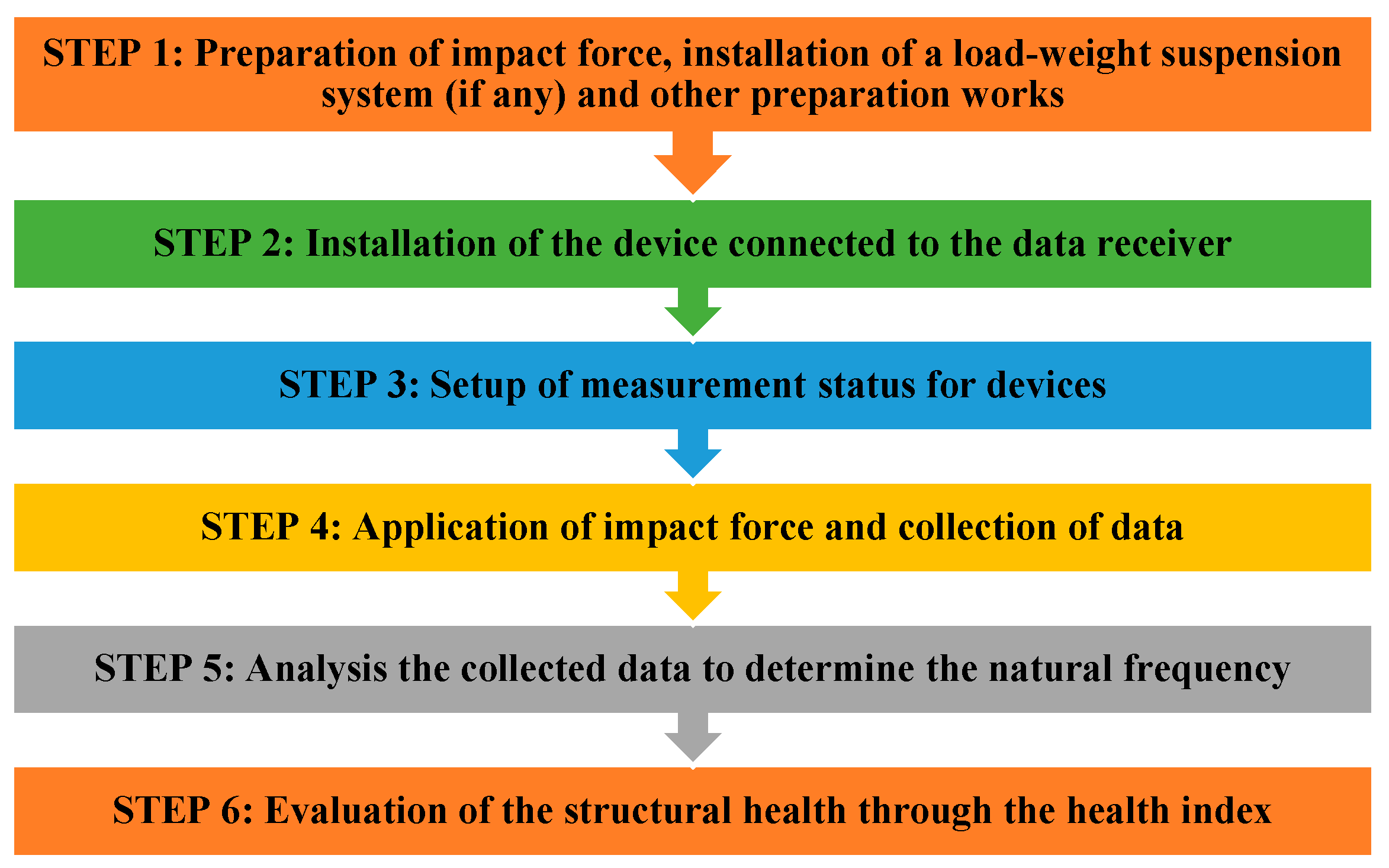
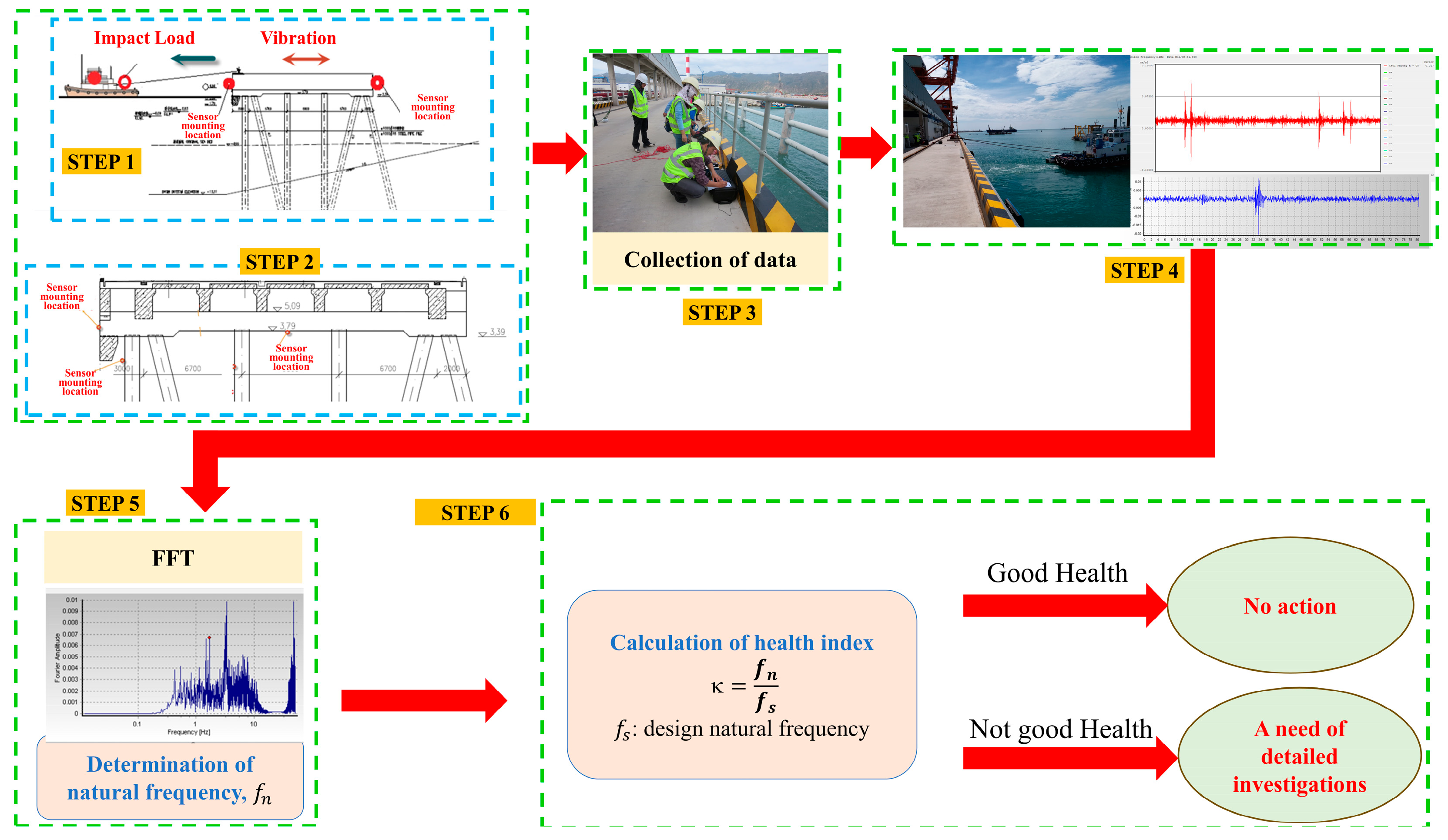
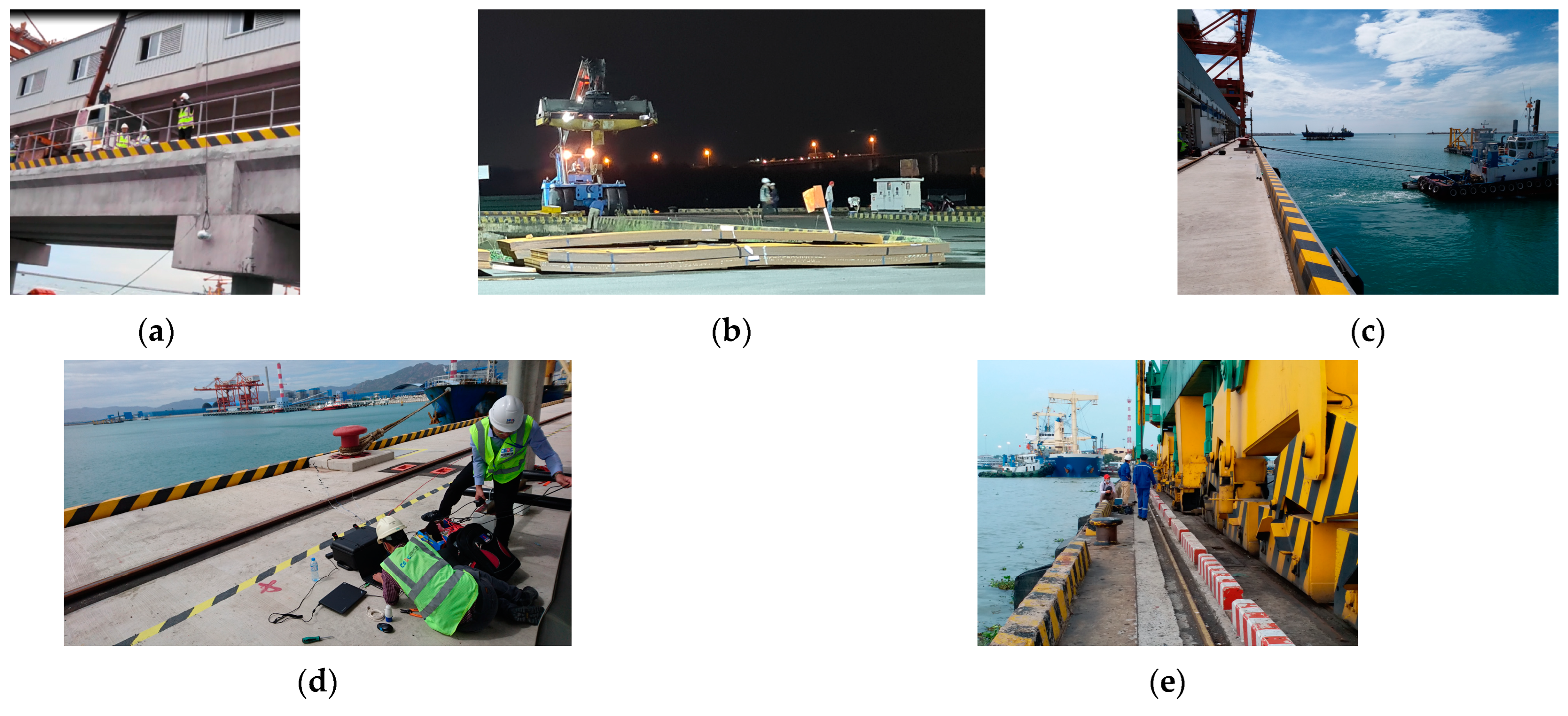




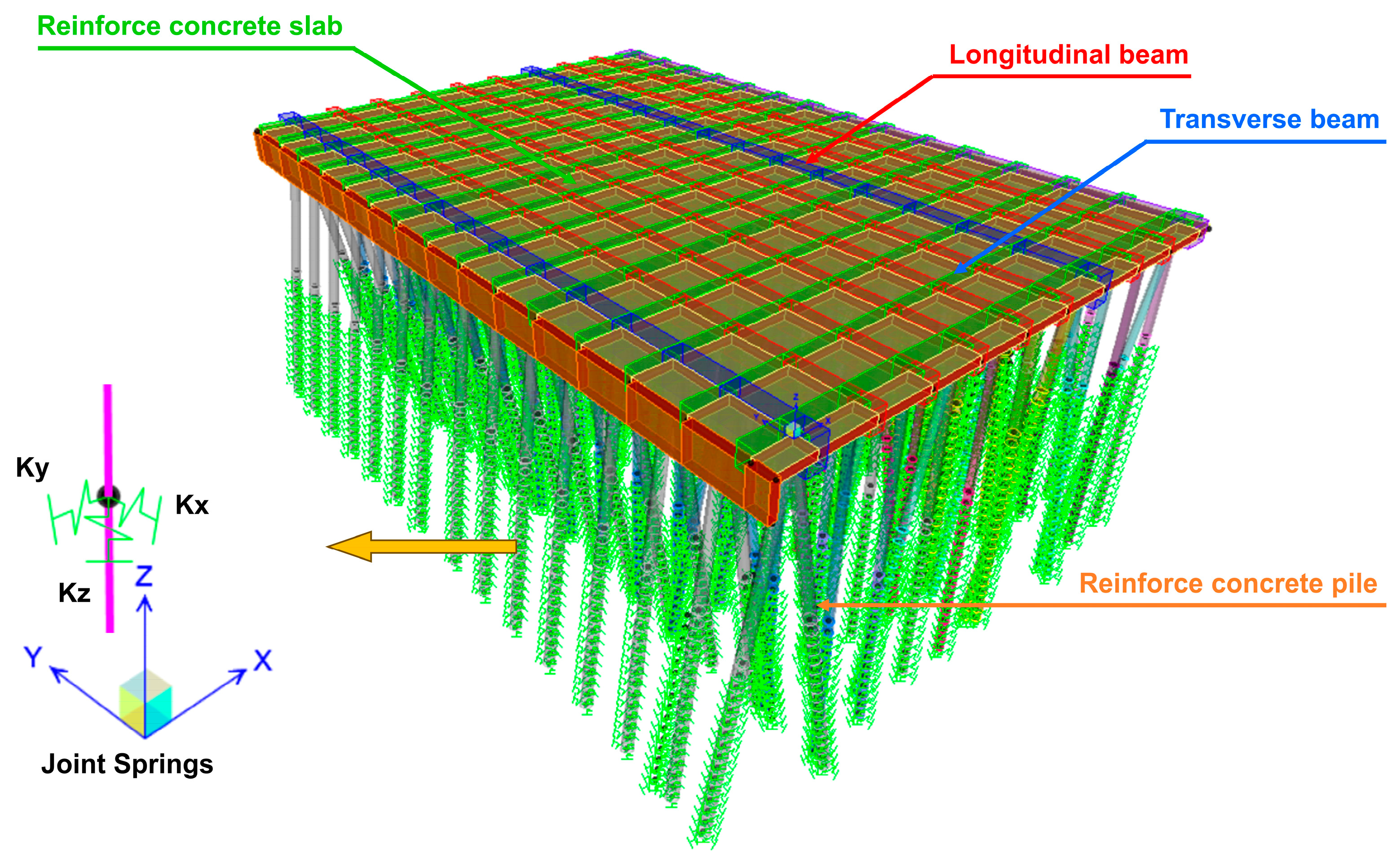
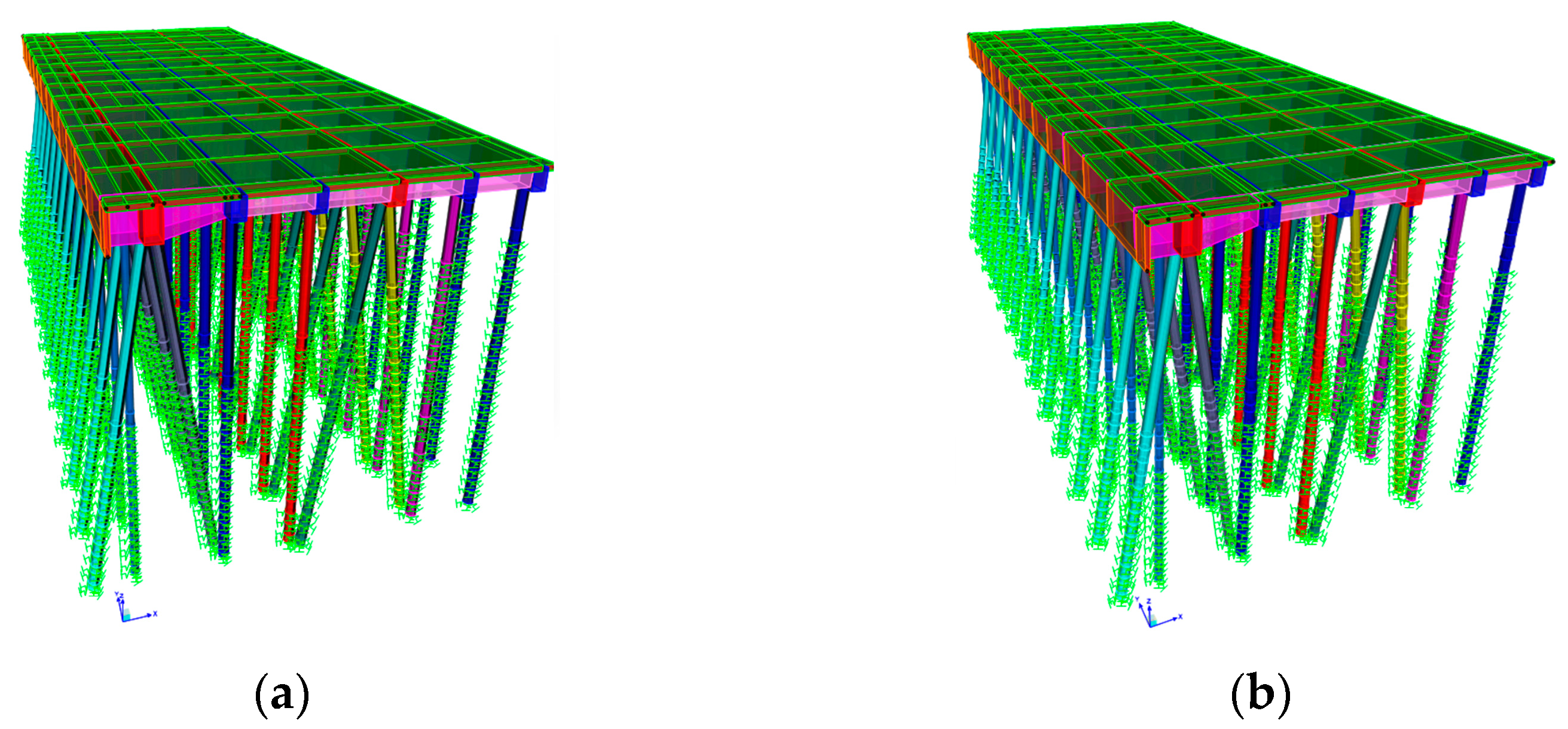
| Health Index (κo) | Level of Evaluation | Situation/Solution |
|---|---|---|
| κo ≤ 0.70 | A1 | Structures undergo dangerous deformation due to external forces at any time. Detailed inspection needs to be conducted for repairs and reinforcement. |
| 0.70 < κo ≤ 0.85 | A2 | The reduction in the structure’s natural frequency needs to be monitored. |
| 0.85 < κo ≤ 1.00 | B | No severe damage is observed on structures. Structures work in a good health condition. |
| 1.00 < κo | S | Structures work in an excellent health condition. |
| No | The Names of Wharves | Level by Crane | Level by Height | Load of 103 DWT Ship | Height (m) | Age (Years) | Location |
|---|---|---|---|---|---|---|---|
| 1 | Tan Vu No.1 | II | II | 20 | 13.45 | 14 | Northern Vietnam |
| 2 | Tan Vu No.2 | II | II | 20 | 13.45 | 14 | |
| 3 | Tan Vu No.3 | II | II | 20 | 13.45 | 12 | |
| 4 | Tan Vu No.4 | II | II | 20 | 13.45 | 12 | |
| 5 | Tan Vu No.5 | II | II | 20 | 13.45 | 11 | |
| 6 | Nam Dinh Vu | I | II | 50 | 14.00 | 0 | |
| 7 | Mipex | I | I | 40 | 17.70 | 3 | |
| 8 | Lach Huyen | Special | I | 80 | 19.50 | 5 | |
| 9 | Nghi Son | II | I | 30 | 17.00 | 5 | Central Vietnam |
| 10 | Cua Lo | II | I | 30 | 16.5 | 5 | |
| 11 | Tan Cang QN | II | I | 30 | 16.7 | 19 | |
| 12 | Hiep Phuoc | I | I | 50 | 19.5 | 10 | Southern Vietnam |
| 13 | Cai Mep Ha | III | II | 10 | 12.4 | 2 | |
| 14 | CMIT | I | I | 60 | 19.7 | 13 | |
| 15 | SITV | Special | Special | 80 | 22 | 12 | |
| 16 | Gemarlink | Special | Special | 200 | 21.5 | 2 | |
| 17 | Cai Cui | II | I | 20 | 15.7 | 17 |
| No. | The Names of Berths | Natural Frequency per Measurement Time (Hz) | ||
|---|---|---|---|---|
| 1st | 2nd | 3rd | ||
| 1 | Tan Vu | 1.30 | 1.1342 | 1.221 |
| 2 | Lach Huyen | 1.049 | 1.428 | 1.135 |
| 3 | Hiep Phuoc | 1.709 | 1.709 | 1.831 |
| 4 | SITV | 1.953 | 2.014 | 1.519 |
| 5 | CMIT | 1.709 | 1.953 | 1.726 |
| 6 | GEMARLINK’s Segment No.1 (GEM 1) | 1.586 | 1.648 | 1.684 |
| 7 | GEMARLINK’s, Segment No.2 (GEM 2) | 1.641 | 1.641 | 1.587 |
| 8 | GEMARLINK’s, Segment No.3 (GEM 3) | 1.802 | 1.647 | 1.886 |
| No. | The Names of Berths | Transverse Natural Frequencies of Berth Segments (Hz) | |||||
|---|---|---|---|---|---|---|---|
| 3KSPT | 4KSPT | 4.5KSPT | 3KIL | 4KIL | 4.5KIL | ||
| 1 | Tan Vu, No.1 | 0.9913 | 1.0292 | 1.0444 | 0.9984 | 0.9484 | 0.9984 |
| 2 | Tan Vu, No.2 | 0.8834 | 0.9194 | 0.9339 | 0.9353 | 0.9373 | 0.9497 |
| 3 | Tan Vu, No.3 | 1.0924 | 1.1177 | 1.1278 | 1.0944 | 1.1178 | 1.1272 |
| 4 | Tan Vu, No.4 | 1.1751 | 1.2046 | 1.2162 | 1.1814 | 1.3266 | 1.3354 |
| 5 | Tan Vu, No.5 | 1.4461 | 1.5328 | 1.5693 | 0.9000 | 0.9307 | 0.8978 |
| 6 | Nam Dinh Vu, Stage 2 | 1.2397 | 1.2967 | 1.3197 | 1.3962 | 0.9950 | 1.3962 |
| 7 | Mipec | 0.9564 | 0.9928 | 1.0074 | 1.0327 | 1.0647 | 1.0770 |
| 8 | Lach Huyen | 1.0169 | 1.0496 | 1.0624 | 1.0204 | 1.0440 | 1.0533 |
| 9 | Nghi Son | 1.0924 | 1.1177 | 1.1278 | 1.0539 | 1.0872 | 1.1008 |
| 10 | Cua Lo | 1.1981 | 1.2373 | 1.2527 | - | - | - |
| 11 | Quy Nhon New | 0.7619 | 0.7786 | 0.7853 | - | - | - |
| 12 | Hiep Phuoc | - | - | - | 0.9363 | 0.9090 | 0.9170 |
| 13 | Cai Mep Ha | 2.0956 | 2.1968 | 2.2381 | 2.6439 | 2.7313 | 2.7663 |
| 14 | SITV | 1.4191 | 1.4191 | 1.4983 | - | - | - |
| 15 | CMIT | - | - | - | 0.8647 | 0.8808 | 0.8872 |
| 16 | GEMARLINK Berth, Segment No.1 (GEM 1) | 0.8852 | 0.9165 | 0.9295 | - | - | - |
| 17 | GEMARLINK Berth, Segment No.2 (GEM 2) | 0.8996 | 0.9312 | 0.9440 | - | - | - |
| 18 | GEMARLINK Berth, Segment No.3 (GEM 3) | 0.8769 | 0.9085 | 0.9213 | - | - | - |
| 19 | Cai Cui | 0.9707 | 1.0180 | 1.0377 | - | - | - |
| No. | Names of Berths | Natural Frequency Based on the Official Design | Natural Frequency Measured | Health Index | |||||
|---|---|---|---|---|---|---|---|---|---|
| SPT | IL | Minimum (M) | Average (A) | SPT | IL | ||||
| M | A | M | A | ||||||
| 1 | Tan Vu No.1 | 0.937 | 0.991 | 1.14 | 1.23 | 1.14 | 1.22 | 1.14 | 1.23 |
| 2 | Lach Huyen | 0.968 | 1.020 | 1.08 | 1.24 | 1.03 | 1.18 | 1.08 | 1.24 |
| 3 | Hiep Phuoc | - | 0.936 | - | - | 1.83 | 1.87 | - | - |
| 4 | SITV | 1.419 | - | 1.07 | 1.29 | - | - | 1.07 | 1.29 |
| 5 | CMIT | - | 0.865 | - | - | 1.98 | 2.08 | - | - |
| 6 | Gem 1 | - | 0.885 | 1.79 | 1.85 | - | - | 1.79 | 1.85 |
| 7 | Gem 2 | - | 0.900 | 1.76 | 1.80 | - | - | 1.76 | 1.80 |
| 8 | Gem 3 | - | 0.877 | 1.88 | 2.03 | - | - | 1.88 | 2.03 |
| Status | Group 1: Normal Working Conditions | Group 2: Limited Working Conditions |
|---|---|---|
| Bottom area in front of the structure: a depth reduction due to dredging, sedimentation, and erosion. | The local depth change tolerance does not exceed 0.5 m on a section with a length of 0.25 L. | Determined through calculation of the structure’s bearing capacity. |
| Reduction in the compressive strength of the concrete of the pile and reduction in the steel pile thickness (corrosion) | ≤10% | >20% |
| Reduction in the compressive strength of the concrete of the beam and deck | ≤20% | >30% |
| General and local deformation, slope landslides | Change the depth at the wharf location within the allowable threshold. | The soil under the wharf is eroded. |
| Status | Type S | Type C | Type B | Type A |
|---|---|---|---|---|
| Bottom area in front of the structure: a depth reduction due to dredging, sedimentation, and erosion. | No | ≤ 0.5 m | Determined through calculation of the structure’s bearing capacity. | Dangerous defects causing collapse. |
| Reduction in the compressive strength of the concrete of the pile and reduction in the steel pile thickness (corrosion). | No | ≤10% | >20% | Dangerous defects. |
| Reduction in the compressive strength of the concrete of the beam and deck | No | ≤20% | >30% | Dangerous defects. |
| General and local deformation, slope landslides | No | Change the depth at the wharf location within the allowable threshold. | The soil under the wharf is eroded. | Dangerous defects. |
| No | Compressive Strength Loss of Concrete (%) | Ec (kN/m2) | f’c (kN/m2) |
|---|---|---|---|
| 1 | 0 | 37,500,000 | 32,639.2 |
| 2 | 10 | 36,333,231 | 29,375.3 |
| 3 | 20 | 35,071,817 | 26,111.3 |
| 4 | 30 | 33,694,629 | 22,847.4 |
| 5 | 40 | 32,171,895 | 19,583.5 |
| 6 | 50 | 30,459,465 | 16,319.6 |
| No. | The Name of Berth | Natural Frequency When Scour Loses Spring Support along the Outermost Row of Piles (Hz) | Natural Frequency When Concrete Strength Decreases (Hz) | ||||||||
|---|---|---|---|---|---|---|---|---|---|---|---|
| 10% | 20% (Beam, Deck), 10% (Pile) | 20% | 30% (Beam, Deck), 20% (Pile) | 30% | 40% | 50% | 1 m | 2 m | 3 m | ||
| 1 | Tan Vu No.1 | 0.991 | 0.980 | 0.980 | 0.967 | 0.967 | 0.953 | 0.937 | 0.918 | 0.897 | 0.801 |
| 2 | Tan Vu No.2 | 0.883 | 0.874 | 0.863 | 0.863 | 0.862 | 0.850 | 0.836 | 0.820 | 0.792 | 0.726 |
| 3 | Tan Vu No.3 | 1.092 | 1.078 | 1.078 | 1.062 | 1.062 | 1.045 | 1.024 | 1.001 | 0.975 | 0.913 |
| 4 | Tan Vu No.4 | 1.175 | 1.160 | 1.160 | 1.143 | 1.143 | 1.124 | 1.103 | 1.078 | 1.030 | 0.914 |
| 5 | Tan Vu No.5 | 1.446 | 1.433 | 1.427 | 1.418 | 1.411 | 1.401 | 1.382 | 1.359 | 1.327 | 1.264 |
| 6 | Nam Dinh Vu, Stage 2 | 1.240 | 1.227 | 1.226 | 1.212 | 1.212 | 1.195 | 1.177 | 1.155 | 1.131 | 1.029 |
| 7 | Mipec | 0.956 | 0.945 | 0.945 | 0.933 | 0.933 | 0.919 | 0.904 | 0.886 | 0.902 | 0.857 |
| 8 | Lach Huyen | 1.017 | 1.009 | 1.009 | 1.001 | 1.000 | 0.991 | 0.980 | 0.967 | 0.967 | 0.911 |
| 9 | Nghi Son | 1.092 | 1.078 | 1.078 | 1.062 | 1.062 | 1.045 | 1.024 | 1.001 | 0.976 | 0.913 |
| 10 | Cua Lo | 1.198 | 1.184 | 1.183 | 1.168 | 1.167 | 1.150 | 1.129 | 1.106 | 1.074 | 1.015 |
| 11 | Quy Nhon New Port | 0.762 | 0.752 | 0.752 | 0.741 | 0.741 | 0.728 | 0.714 | 0.698 | 0.707 | 0.646 |
| 12 | Cai Mep Ha | 2.096 | 2.074 | 2.071 | 2.049 | 2.046 | 2.022 | 1.991 | 1.955 | 1.996 | 1.915 |
| 13 | SITV | 1.419 | 1.403 | 1.402 | 1.385 | 1.384 | 1.365 | 1.342 | 1.316 | 1.346 | 1.285 |
| 14 | GEM 1 | 0.885 | 0.882 | 0.882 | 0.878 | 0.878 | 0.874 | 0.869 | 0.863 | 0.855 | 0.828 |
| 15 | GEM 2 | 0.900 | 0.895 | 0.894 | 0.889 | 0.889 | 0.883 | 0.876 | 0.868 | 0.860 | 0.827 |
| 16 | GEM 3 | 0.877 | 0.873 | 0.873 | 0.869 | 0.868 | 0.864 | 0.859 | 0.852 | 0.844 | 0.815 |
| 17 | Cai Cui | 0.971 | 0.961 | 0.960 | 0.949 | 0.949 | 0.937 | 0.922 | 0.906 | 0.926 | 0.865 |
| No | The Name of Berth | Health Index | |||||||||
|---|---|---|---|---|---|---|---|---|---|---|---|
| Compressive Strength Loss of Concrete | Elastic Support Loss along the Outermost Row of Piles Due to Erosion | ||||||||||
| 10% | 20% (Beam, Deck), 10% (Pile) | 20% | 30% (Beam, Deck), 20% (Pile) | 30% | 40% | 50% | 1 m | 2 m | 3 m | ||
| 1 | Tan Vu No.1 | 0.99 | 0.99 | 0.98 | 0.98 | 0.96 | 0.95 | 0.93 | 0.90 | 0.81 | 0.73 |
| 2 | Tan Vu No.2 | 0.99 | 0.98 | 0.98 | 0.98 | 0.96 | 0.95 | 0.93 | 0.90 | 0.82 | 0.74 |
| 3 | Tan Vu No.3 | 0.99 | 0.99 | 0.97 | 0.97 | 0.96 | 0.94 | 0.92 | 0.89 | 0.84 | 0.75 |
| 4 | Tan Vu No.4 | 0.99 | 0.99 | 0.97 | 0.97 | 0.96 | 0.94 | 0.92 | 0.88 | 0.78 | 0.70 |
| 5 | Tan Vu No.5 | 0.99 | 0.99 | 0.98 | 0.98 | 0.97 | 0.96 | 0.94 | 0.92 | 0.87 | 0.83 |
| 6 | Nam Dinh Vu, Stage 2 | 0.99 | 0.99 | 0.98 | 0.98 | 0.96 | 0.95 | 0.93 | 0.91 | 0.83 | 0.77 |
| 7 | Mipec | 0.99 | 0.99 | 0.98 | 0.98 | 0.96 | 0.95 | 0.93 | 0.94 | 0.90 | 0.86 |
| 8 | Lach Huyen | 0.99 | 0.99 | 0.98 | 0.98 | 0.97 | 0.96 | 0.95 | 0.95 | 0.90 | 0.85 |
| 9 | Nghi Son | 0.99 | 0.99 | 0.97 | 0.97 | 0.96 | 0.94 | 0.92 | 0.89 | 0.84 | 0.75 |
| 10 | Cua Lo | 0.99 | 0.99 | 0.97 | 0.97 | 0.96 | 0.94 | 0.92 | 0.90 | 0.85 | 0.81 |
| 11 | Quy Nhon New Port | 0.99 | 0.99 | 0.97 | 0.97 | 0.96 | 0.94 | 0.85 | 0.93 | 0.85 | 0.77 |
| 12 | Cai Mep Ha | 0.99 | 0.99 | 0.98 | 0.98 | 0.96 | 0.95 | 0.93 | 0.95 | 0.91 | 0.87 |
| 13 | SITV | 0.99 | 0.99 | 0.98 | 0.98 | 0.96 | 0.95 | 0.93 | 0.95 | 0.91 | 0.87 |
| 14 | GEM 1 | 1.00 | 1.00 | 0.99 | 0.99 | 0.99 | 0.98 | 0.98 | 0.97 | 0.94 | 0.91 |
| 15 | GEM 2 | 0.99 | 0.99 | 0.99 | 0.99 | 0.98 | 0.97 | 0.97 | 0.96 | 0.92 | 0.89 |
| 16 | GEM 3 | 1.00 | 1.00 | 0.99 | 0.99 | 0.99 | 0.98 | 0.97 | 0.96 | 0.93 | 0.90 |
| 17 | Cai Cui | 0.99 | 0.99 | 0.98 | 0.98 | 0.96 | 0.95 | 0.93 | 0.95 | 0.89 | 0.82 |
| No | The Name of Berth | Level of Evaluation | |||||||||
|---|---|---|---|---|---|---|---|---|---|---|---|
| Compressive Strength Loss of Concrete | Elastic Support Lossy along the Outermost Row of Piles Due to Erosion | ||||||||||
| 10% | 20% (Beam, Deck), 10% (Pile) | 20% | 30% (Beam, Deck), 20% (Pile) | 30% | 40% | 50% | 1 m | 2 m | 3 m | ||
| 1 | Tan Vu No.1 | B | B | B | B | B | B | B | B | A1 | A1 |
| 2 | Tan Vu No.2 | B | B | B | B | B | B | B | B | A1 | A1 |
| 3 | Tan Vu No.3 | B | B | B | B | B | B | B | B | A1 | A1 |
| 4 | Tan Vu No.4 | B | B | B | B | B | B | B | B | A1 | A1 |
| 5 | Tan Vu No.5 | B | B | B | B | B | B | B | B | B | A1 |
| 6 | Nam Dinh Vu, Stage 2 | B | B | B | B | B | B | B | B | A1 | A1 |
| 7 | Mipec | B | B | B | B | B | B | B | B | B | B |
| 8 | Lach Huyen | B | B | B | B | B | B | B | B | B | B |
| 9 | Nghi Son | B | B | B | B | B | B | B | B | A1 | A1 |
| 10 | Cua Lo | B | B | B | B | B | B | B | B | A1 | A1 |
| 11 | Quy Nhon New Port | B | B | B | B | B | B | B | B | A1 | A1 |
| 12 | Cai Mep Ha | B | B | B | B | B | B | B | B | B | B |
| 13 | SITV | B | B | B | B | B | B | B | B | B | B |
| 14 | GEM 1 | B | B | B | B | B | B | B | B | B | B |
| 15 | GEM 2 | B | B | B | B | B | B | B | B | B | B |
| 16 | GEM 3 | B | B | B | B | B | B | B | B | B | B |
| 17 | Cai Cui | B | B | B | B | B | B | B | B | B | A1 |
| No | Name | Factor K with a Compressive Strength Loss of Concrete (20% in Beam and Deck, 10% in Pile) | Compared to 0.85 |
|---|---|---|---|
| 1 | Tan Vu No.1 | 0.988 | 1.16 |
| 2 | Tan Vu No.2 | 0.976 | 1.15 |
| 3 | Tan Vu No.3 | 0.987 | 1.16 |
| 4 | Tan Vu No.4 | 0.987 | 1.16 |
| 5 | Tan Vu No.5 | 0.986 | 1.16 |
| 6 | Nam Dinh Vu, Stage 2 | 0.989 | 1.16 |
| 7 | Mipec | 0.988 | 1.16 |
| 8 | Lach Huyen | 0.992 | 1.17 |
| 9 | Nghi Son | 0.987 | 1.16 |
| 10 | Cua Lo | 0.988 | 1.16 |
| 11 | Quy Nhon New Port | 0.987 | 1.16 |
| 12 | Cai Mep Ha | 0.989 | 1.16 |
| 13 | SITV | 0.988 | 1.16 |
| 14 | GEM 1 | 0.988 | 1.16 |
| 15 | GEM 2 | 0.996 | 1.17 |
| 16 | GEM 3 | 0.994 | 1.17 |
| 17 | Cai Cui Berth | 0.995 | 1.17 |
| Health Index (κo) | Level | Situation/Solution |
|---|---|---|
| κo ≤ 0.81 | A1 | Structures undergo dangerous deformation due to an external force at any time. Detailed inspection needs to be conducted for repairs and reinforcement. |
| 0.81 < κo ≤ 0.98 | A2 | The reduction in the structure’s natural frequency needs to be monitored. |
| 0.98 < κo ≤ 1.16 | B | No severe damage is observed in structures. Structures work in a good health condition. |
| 1.16 < κo | S | Structures work in an excellent health condition. |
Disclaimer/Publisher’s Note: The statements, opinions and data contained in all publications are solely those of the individual author(s) and contributor(s) and not of MDPI and/or the editor(s). MDPI and/or the editor(s) disclaim responsibility for any injury to people or property resulting from any ideas, methods, instructions or products referred to in the content. |
© 2024 by the authors. Licensee MDPI, Basel, Switzerland. This article is an open access article distributed under the terms and conditions of the Creative Commons Attribution (CC BY) license (https://creativecommons.org/licenses/by/4.0/).
Share and Cite
Nguyen, T.B.D.; Huh, J.; Vu, T.T.; Tran, M.L.; Mac, V.H. Development of Indicator for Piled Pier Health Evaluation in Vietnam Using Impact Vibration Test Approach. Buildings 2024, 14, 2366. https://doi.org/10.3390/buildings14082366
Nguyen TBD, Huh J, Vu TT, Tran ML, Mac VH. Development of Indicator for Piled Pier Health Evaluation in Vietnam Using Impact Vibration Test Approach. Buildings. 2024; 14(8):2366. https://doi.org/10.3390/buildings14082366
Chicago/Turabian StyleNguyen, Thi Bach Duong, Jungwon Huh, Thanh Thai Vu, Minh Long Tran, and Van Ha Mac. 2024. "Development of Indicator for Piled Pier Health Evaluation in Vietnam Using Impact Vibration Test Approach" Buildings 14, no. 8: 2366. https://doi.org/10.3390/buildings14082366
APA StyleNguyen, T. B. D., Huh, J., Vu, T. T., Tran, M. L., & Mac, V. H. (2024). Development of Indicator for Piled Pier Health Evaluation in Vietnam Using Impact Vibration Test Approach. Buildings, 14(8), 2366. https://doi.org/10.3390/buildings14082366









